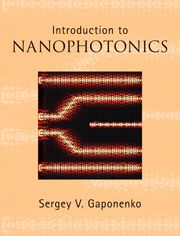Book contents
- Frontmatter
- Contents
- Preface
- Notations and acronyms
- 1 Introduction
- Part I Electrons and electromagnetic waves in nanostructures
- 2 Basic properties of electromagnetic waves and quantum particles
- 3 Wave optics versus wave mechanics I
- 4 Electrons in periodic structures and quantum confinement effects
- 5 Semiconductor nanocrystals (quantum dots)
- 6 Nanoplasmonics I: metal nanoparticles
- 7 Light in periodic structures: photonic crystals
- 8 Light in non-periodic structures
- 9 Photonic circuitry
- 10 Tunneling of light
- 11 Nanoplasmonics II: metal–dielectric nanostructures
- 12 Wave optics versus wave mechanics II
- Part II Light–matter interaction in nanostructures
- Author index
- Subject index
7 - Light in periodic structures: photonic crystals
from Part I - Electrons and electromagnetic waves in nanostructures
Published online by Cambridge University Press: 05 June 2012
- Frontmatter
- Contents
- Preface
- Notations and acronyms
- 1 Introduction
- Part I Electrons and electromagnetic waves in nanostructures
- 2 Basic properties of electromagnetic waves and quantum particles
- 3 Wave optics versus wave mechanics I
- 4 Electrons in periodic structures and quantum confinement effects
- 5 Semiconductor nanocrystals (quantum dots)
- 6 Nanoplasmonics I: metal nanoparticles
- 7 Light in periodic structures: photonic crystals
- 8 Light in non-periodic structures
- 9 Photonic circuitry
- 10 Tunneling of light
- 11 Nanoplasmonics II: metal–dielectric nanostructures
- 12 Wave optics versus wave mechanics II
- Part II Light–matter interaction in nanostructures
- Author index
- Subject index
Summary
“I have discussed in a recent paper the propagation of waves in an infinite laminated medium …, and have shown that, however slight the variation, reflexion is ultimately total, provided the agreement be sufficiently close between the wavelength of the structure and the half-wavelength of the vibration.”
Lord Rayleigh, 1888The photonic crystal concept
Since the time when de Broglie published his hypothesis on the wave properties of matter particles in 1923, the wave mechanics of matter has become a well-developed field of science. It has provided an explanation for the properties of atoms, molecules and solids. Furthermore, it predicted novel properties of artificial solids like quantum wells and quantum wires. As we have seen in Chapters 2 and 3, there are many common features and phenomena in wave mechanics and wave optics. At the very dawn of wave mechanics, it essentially borrowed much from wave optics.
Nowadays, the reverse process manifests itself in science. Results of quantum mechanics which are direct consequences of the wave properties of electrons and other quantum particles are transferred to classical electromagnetism, and to wave optics. These are results that are not related directly to spin and charge. Such transfers have formed a new emerging field in modern optics of inhomogeneous media with the concept of a photonic crystal at the heart of the field.
- Type
- Chapter
- Information
- Introduction to Nanophotonics , pp. 199 - 245Publisher: Cambridge University PressPrint publication year: 2010



